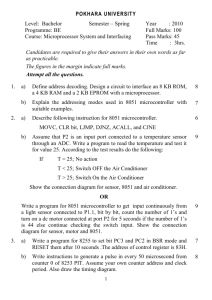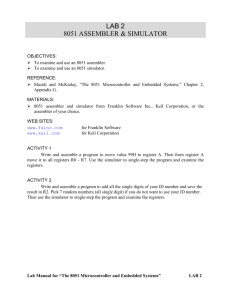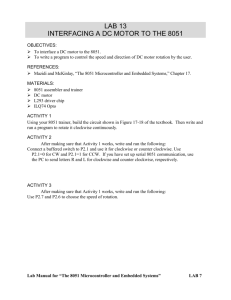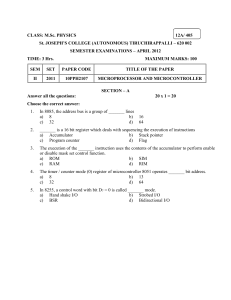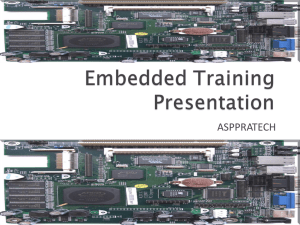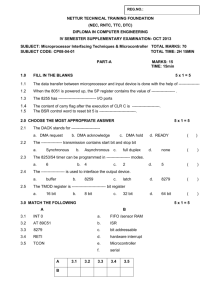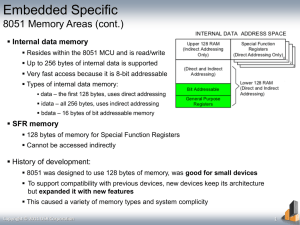4th Semester Course Outcomes
advertisement
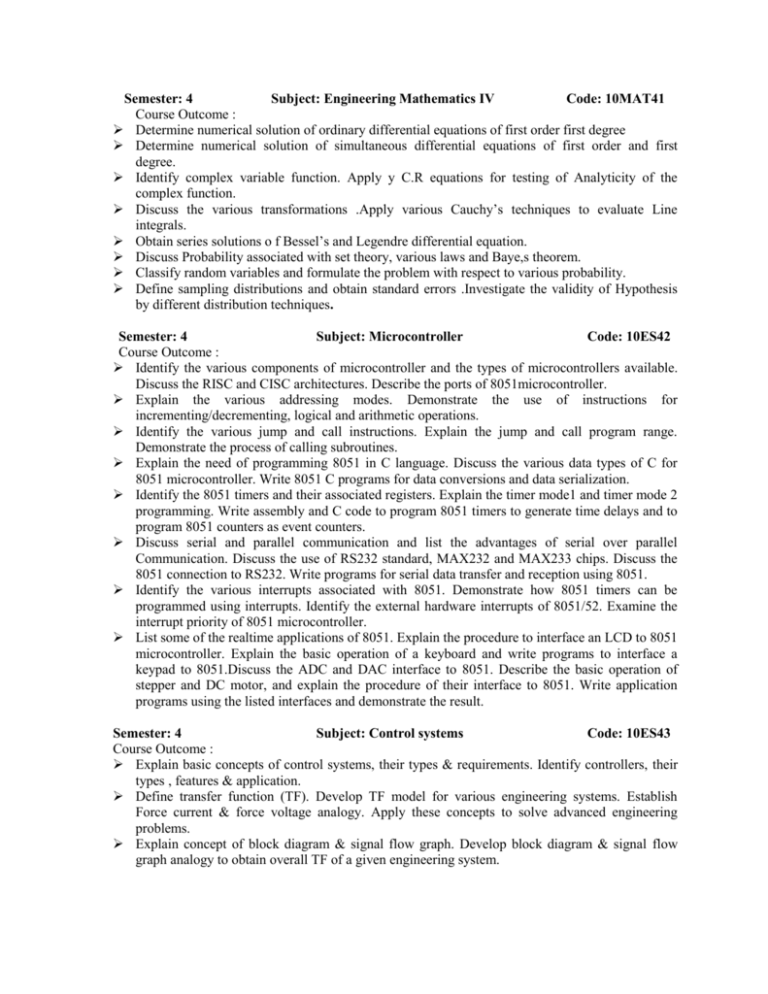
Semester: 4 Subject: Engineering Mathematics IV Code: 10MAT41 Course Outcome : Determine numerical solution of ordinary differential equations of first order first degree Determine numerical solution of simultaneous differential equations of first order and first degree. Identify complex variable function. Apply y C.R equations for testing of Analyticity of the complex function. Discuss the various transformations .Apply various Cauchy’s techniques to evaluate Line integrals. Obtain series solutions o f Bessel’s and Legendre differential equation. Discuss Probability associated with set theory, various laws and Baye,s theorem. Classify random variables and formulate the problem with respect to various probability. Define sampling distributions and obtain standard errors .Investigate the validity of Hypothesis by different distribution techniques. Semester: 4 Subject: Microcontroller Code: 10ES42 Course Outcome : Identify the various components of microcontroller and the types of microcontrollers available. Discuss the RISC and CISC architectures. Describe the ports of 8051microcontroller. Explain the various addressing modes. Demonstrate the use of instructions for incrementing/decrementing, logical and arithmetic operations. Identify the various jump and call instructions. Explain the jump and call program range. Demonstrate the process of calling subroutines. Explain the need of programming 8051 in C language. Discuss the various data types of C for 8051 microcontroller. Write 8051 C programs for data conversions and data serialization. Identify the 8051 timers and their associated registers. Explain the timer mode1 and timer mode 2 programming. Write assembly and C code to program 8051 timers to generate time delays and to program 8051 counters as event counters. Discuss serial and parallel communication and list the advantages of serial over parallel Communication. Discuss the use of RS232 standard, MAX232 and MAX233 chips. Discuss the 8051 connection to RS232. Write programs for serial data transfer and reception using 8051. Identify the various interrupts associated with 8051. Demonstrate how 8051 timers can be programmed using interrupts. Identify the external hardware interrupts of 8051/52. Examine the interrupt priority of 8051 microcontroller. List some of the realtime applications of 8051. Explain the procedure to interface an LCD to 8051 microcontroller. Explain the basic operation of a keyboard and write programs to interface a keypad to 8051.Discuss the ADC and DAC interface to 8051. Describe the basic operation of stepper and DC motor, and explain the procedure of their interface to 8051. Write application programs using the listed interfaces and demonstrate the result. Semester: 4 Subject: Control systems Code: 10ES43 Course Outcome : Explain basic concepts of control systems, their types & requirements. Identify controllers, their types , features & application. Define transfer function (TF). Develop TF model for various engineering systems. Establish Force current & force voltage analogy. Apply these concepts to solve advanced engineering problems. Explain concept of block diagram & signal flow graph. Develop block diagram & signal flow graph analogy to obtain overall TF of a given engineering system. Explain the concepts of time response & standard test signals. Analyze. & evaluate time Response specifications for first & second order systems. Evaluate system stability using Routh’s Hurwitz Criterion. Explain procedure for construction of root locus plot. & analyze given system TF for stability. Explain the concepts of frequency response & stability in frequency domain. Develop Polar plot & determine relative & absolute stability of given TF using Nyquist criterion. Explain the procedure of plotting Bode diagrams & Evaluate system stability of given system TF. Explain the concept of state and state variables. Develop a state model. Semester: 4 Subject: Signals and systems Code: 10EC44 Course Outcome : Determine the mathematical representation of signals and systems, signal energy and power, transformation of signal independent variable, properties of periodic signals, even and odd signal, exponential and sinusoidal signal, unit impulse and unit step. Derive the equation describing the relationship between input and output of continuous time and discrete time systems. Determining basic system properties Derive and calculate the convolution sum and integral of Linear Time Invariant System. Determine the convolution properties of LTI systems. Determine the difference and differential equation of LTI systems. Determine the Response of LTI Systems to Complex Exponentials, Fourier Series Representation of Continuous Time Periodic Signals, Properties of Continuous‑Time Fourier series, and Fourier Series Representation of Discrete Time Periodic Signals. Determine Continuous Time Fourier Transform, Discrete Time Fourier Transform. For Aperiodic signals, Fourier Transform of periodic signal, and properties of Fourier Transforms. Analysis of signals and systems from the time and frequency characteristics using Fourier Transforms. Use the FT or DTFT representation for periodic signals to analyze mixtures of periodic and aperiodic signals. Determine the FT representation of a sampled signal. Determine the conditions on the sampling rate or interval that guarantee a band limited signal can be uniquely reconstructed from its samples Derive and determine z Transform,, region of convergence and their properties. Determine the inverse z transform. Demonstrate the solving of difference equation using z transform. Obtain system/transfer function through z transform. Derive block diagram representation from system functions. Plan Poles & Zeros plot. Evaluate Fourier Transform from Pole Zero plots. Semester: 4 Subject: Fundamentals of HDL Code: 10EC45 Course Outcome : Explain the structure of HDL module. Discuss different types of operators and data types. Compare VHDL and Verilog. Design and implement digital circuit in data flow description using VHDL and Verilog code. Discuss the data type vectors. Design and implement digital circuit in behavioral description using VHDL and Verilog code. Explain VHDL variable assignment statements. Design and implement digital circuits in structural description using VHDL and Verilog code. Explain generate, generic and parameter statements. Discuss procedures, tasks and functions. Explain the concepts of file processing. Discuss mixed type description, VHDL user defined types and VHDL packages Discuss mixed language description. Explain the procedure to invoke one language from the other. Also explain the limitations of mixed language description. Explain the concepts of synthesis. Discuss the synthesis information from the entity and module, and mapping process and always in the hardware domain. Semester: 4 Subject: Linear integrated circuits Code: 10EC46 Course Outcome : Investigate the building blocks of a basic opamp, determine opamp parameters and design basic amplifier circuit applications using opamps Discuss, investigate and design various types of capacitor coupled opamp circuits. Explain the stability issues of opamp circuits, assess opamp frequency response and design circuits to realize frequency compensation. Discuss and design various opamp applications such as voltage /current sources, instrumentation amplifier, precision rectifier, limiting circuits etc. Explain the operation and design of signal generating circuits, V to I and I to V converters, oscillator circuits using opamp. Evaluate and design the first order and second order active low/high pass filter circuits using opamp Explain the basics of a voltage regulator and discuss in detail the different types of voltage regulator designs. Describe the internals of basic 555 timer and further apply it to design multi vibrators, Schmitt trigger, A/D and D/A converters.
